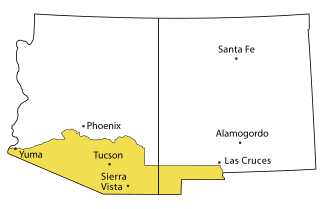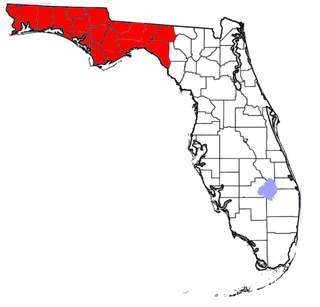Related Research Articles

Alabama became a state of the United States of America on December 14, 1819. After Indian Removal forcibly displaced most Southeast tribes to west of the Mississippi River to what was then called Indian Territory, European-Americans arrived in large numbers, bringing or buying African Americans in the domestic slave trade.

The Compromise of 1850 was a package of five separate bills passed by the United States Congress in September 1850 that defused a political confrontation between slave and free states on the status of territories acquired in the Mexican–American War. It also set Texas's western and northern borders and included provisions addressing fugitive slaves and the slave trade. The compromise was brokered by Whig senator Henry Clay and Democratic senator Stephen A. Douglas, with the support of President Millard Fillmore.

The Gadsden Purchase is a 29,670-square-mile (76,800 km2) region of present-day southern Arizona and southwestern New Mexico that the United States acquired from Mexico by the Treaty of Mesilla, which took effect on June 8, 1854. The purchase included lands south of the Gila River and west of the Rio Grande where the U.S. wanted to build a transcontinental railroad along a deep southern route, which the Southern Pacific Railroad later completed in 1881–1883. The purchase also aimed to resolve other border issues.
The Pacific Railroad Acts of 1862 were a series of acts of Congress that promoted the construction of a "transcontinental railroad" in the United States through authorizing the issuance of government bonds and the grants of land to railroad companies. The War Department under then Secretary of War Jefferson Davis was authorized by the Congress in 1853 to conduct surveys of five different potential transcontinental routes from the Mississippi ranging from north to south and submitted a massive twelve volume report to Congress with the results in early 1855. However, no route or bill could be agreed upon and passed authorizing the Government's financial support and land grants until the secession of the southern states in 1861 removed their opposition to a central route. The Pacific Railroad Act of 1862 was the original act. Some of its provisions were subsequently modified, expanded, or repealed by four additional amending Acts: The Pacific Railroad Act of 1863, Pacific Railroad Act of 1864, Pacific Railroad Act of 1865, and Pacific Railroad Act of 1866.

The State of Deseret was a provisional state of the United States, proposed in 1849 by settlers from The Church of Jesus Christ of Latter-day Saints in Salt Lake City. The provisional state existed for slightly over two years and was never recognized by the United States government. The name derives from the word for "honeybee" in the Book of Mormon.

The Florida Panhandle is the northwestern part of the U.S. state of Florida; it is a strip of land roughly 200 miles (320 km) long and 50 to 100 miles wide, lying between Alabama on the north and the west, Georgia on the north, and the Gulf of Mexico to the south. Its eastern boundary is arbitrarily defined. In terms of population, major communities include Tallahassee, Pensacola, and Navarre.

John Archibald Campbell was an American jurist. He was a successful lawyer in Georgia and Alabama, where he served in the state legislatures. Appointed by Franklin Pierce to the United States Supreme Court in 1853, he served until the outbreak of the American Civil War, when he became an official of the Confederate States of America. After serving six months in a military prison, he resumed a successful law practice in New Orleans, where he opposed Reconstruction.

David Levy Yulee was an American politician and attorney. Born in St. Thomas, then under British control, he was of Sephardi Jewish ancestry: his father was from Morocco and his mother, also of Sephardi descent, was born in Sint Eustatius and raised in St. Thomas. The family moved to Florida when he was a child, and he grew up there on their extensive lands. He later served as Florida's territorial delegate to Congress. Yulee was the first person of Jewish ancestry to be elected and serve as a United States Senator, serving 1845–1851 and again 1855–1861. He founded the Florida Railroad Company and served as president of several other companies, earning the nickname of "Father of Florida Railroads." In 2000 he was recognized as a "Great Floridian" by the state.

The Illinois Central Railroad, sometimes called the Main Line of Mid-America, was a railroad in the central United States, with its primary routes connecting Chicago, Illinois, with New Orleans, Louisiana, and Mobile, Alabama. A line also connected Chicago with Sioux City, Iowa (1870). There was a significant branch to Omaha, Nebraska (1899), west of Fort Dodge, Iowa, and another branch reaching Sioux Falls, South Dakota (1877), starting from Cherokee, Iowa. The Sioux Falls branch has been abandoned in its entirety.

The 36th United States Congress was a meeting of the legislative branch of the United States federal government, consisting of the United States Senate and the United States House of Representatives. It met in Washington, D.C. from March 4, 1859, to March 4, 1861, during the third and fourth years of James Buchanan's presidency. The apportionment of seats in the House of Representatives was based on the Seventh Census of the United States in 1850. The Senate had a Democratic majority, and the House had a Republican plurality.
The Montgomery and West Point Railroad (M&WP) was an early 19th-century railroad in Alabama and Georgia. It played an important role during the American Civil War as a supply and transportation route for the Confederate Army, and, as such, was the target of a large raid by Union cavalry in the summer of 1864, called Wilson's Raid. The railroad played an important role in this business, and it became a symbol to industrialization in the United States. The railroads make it possible to supply large military forces that were needed in order to take over and conquer the Southern part of the United States. During the early 19th-century, turnpikes, canals, and railroads all brought people to the west and more products to the east. There was an effort in Americans during this time to build a railroad that would link Georgia to trade with the Tennessee and Ohio areas, and the M&WP was a starting point in helping to accomplish this goal.
The Jacksonville, Tampa and Key West Railway was a railroad and steamboat network in Florida, USA at the end of the 19th century. Most of its lines became part of the Plant System in 1899 and the Atlantic Coast Line Railroad in 1902. The line remains in service today with a vast majority of it now being CSX Transportation's Sanford Subdivision.

The 38th United States Congress was a meeting of the legislative branch of the United States federal government, consisting of the United States Senate and the United States House of Representatives. It met in Washington, D.C. from March 4, 1863, to March 4, 1865, during the last two years of the first administration of U.S. President Abraham Lincoln. The apportionment of seats in the House of Representatives was based on the Eighth Census of the United States in 1860. The Senate had a Republican majority, and the House of Representatives had a Republican plurality.
The Supreme Court decision in Illinois Central Railroad v. Illinois, 146 U.S. 387 (1892), reaffirmed that each state in its sovereign capacity holds permanent title to all submerged lands within its borders and holds these lands in public trust. This is a foundational case for the public trust doctrine. The Supreme Court held a four to three split decision that the State of Illinois did not possess the authority to grant fee title to submerged lands held in the public trust as navigable waters.

William Williams Chapman was an American politician and lawyer in Oregon and Iowa. He was born and raised in Virginia. He served as a United States Attorney in Iowa when it was part of the Michigan and Wisconsin territories, and then represented the Iowa Territory in the United States House of Representatives. He later immigrated to the Oregon Country, where he served in the Oregon Territorial Legislature.
The Alabama Great Southern Railroad is a railroad in the U.S. states of Alabama, Georgia, Louisiana, Mississippi, and Tennessee. It is an operating subsidiary of the Norfolk Southern Corporation (NS), running southwest from Chattanooga to New Orleans through Birmingham and Meridian. The AGS also owns about a 30% interest in the Kansas City Southern-controlled Meridian-Shreveport Meridian Speedway.

The Pensacola and Atlantic Railroad (P&A) was a company incorporated by an act of the Florida Legislature on March 4, 1881, to run from Pensacola to the Apalachicola River near Chattahoochee, a distance of about 160 miles (260 km). No railroad had ever been built across the sparsely populated panhandle of Florida, which left Pensacola isolated from the rest of the state. William D. Chipley and Frederick R. De Funiak, both of whom are commemorated in the names of towns later built along the P&A line, were among the founding officers of the railroad company.
The Winona and St. Peter Railroad was a railroad in the Midwestern United States. It was founded in 1861 in Winona, Minnesota. The first 11 miles (18 km) from Winona to Stockton, Minnesota, were completed by the end of 1862, making the it the second operational railroad in Minnesota, after the St. Paul and Pacific Line from Saint Paul to St. Anthony Falls.
The Land Grant Act of 1850 provided for 3.75 million acres of land to the states to support railroad projects; by 1857 21 million acres of public lands were used for railroads in the Mississippi River valley, and the stage was set for more substantial Congressional subsidies to future railroads.
The Alabama and Florida Railroad was a line of rail track connecting Pensacola, Florida with Montgomery, Alabama during the late 1850s and early 1860s. The portion of the line in Alabama was first owned by the Alabama and Florida Rail Road Company, while the portion of the line in Florida was owned by the Alabama and Florida Railroad.
References
- ↑ "AN ACT: To incorporate the Alabama and Florida Rail Road Company". Alabama legislative acts, November 1849 through February 1850. Alabama Legislature. 1849. p. 173. Retrieved August 18, 2020. p. 174:
Sec. 4. ... incorporated into a company by the name of the Alabama and Florida rail road company
- ↑ "An Act granting Public Lands, in alternate Sections, to the States of Florida and Alabama, to aid in the Construction of certain Railroads in said States" (PDF). Library of Congress.
- ↑ "Act of General Assembly of Alabama". p. 82.